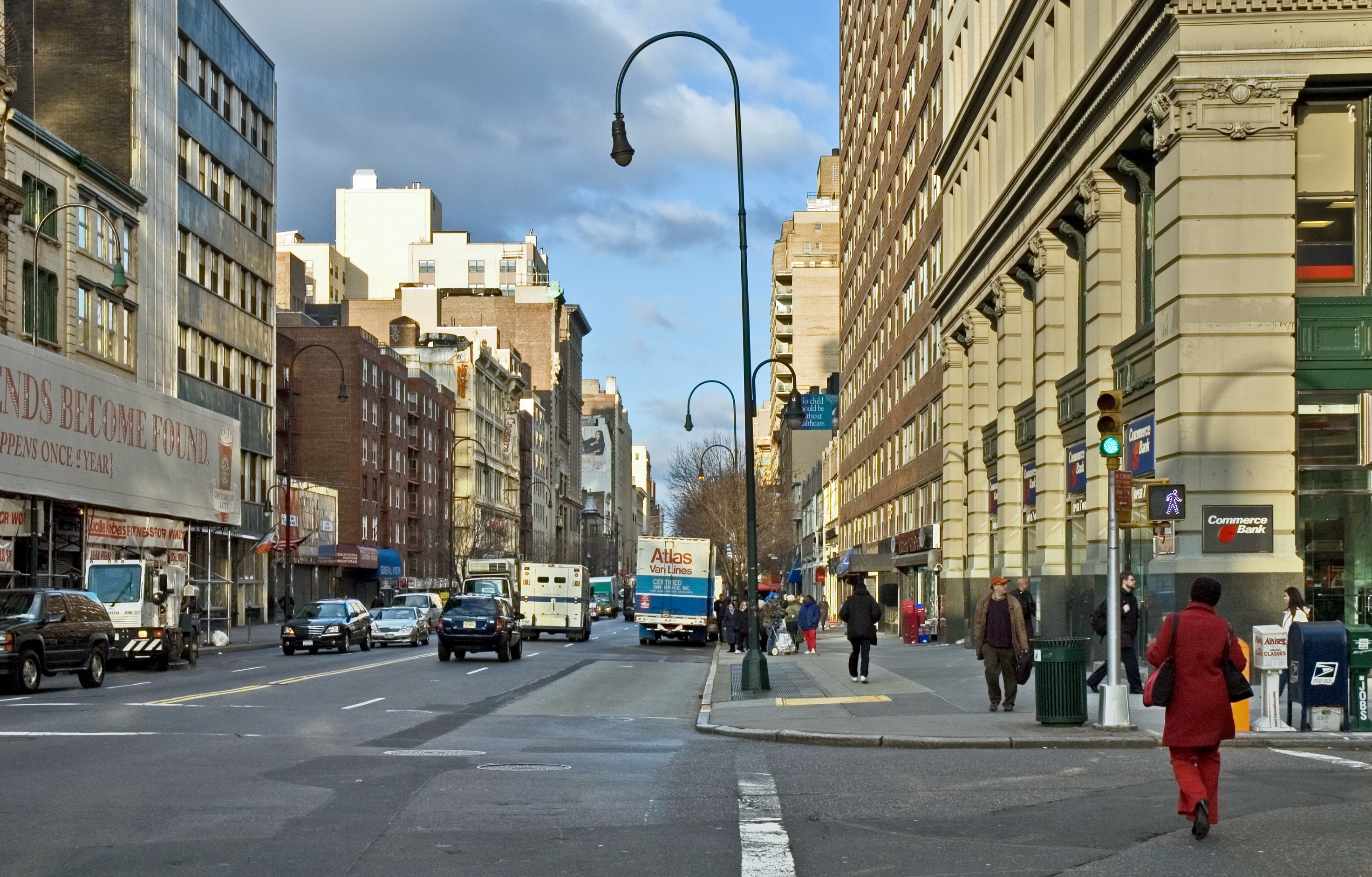
14th Street (Manhattan)
14th Street is a major crosstown street in the New York City borough of Manhattan, traveling between Eleventh Avenue on Manhattan's West Side and Avenue C on Manhattan's East Side. It forms a boundary between several neighborhoods and is sometimes considered the border between Lower Manhattan and Midtown Manhattan.
For other uses, see 14th Street.Maintained by
At Broadway, 14th Street forms the southern boundary of Union Square. It is also considered the southern boundary of Chelsea, Flatiron/Lower Midtown, and Gramercy, and the northern boundary of Greenwich Village, Alphabet City, and the East Village. West of Third Avenue, 14th Street marks the southern terminus of western Manhattan's grid system. North of 14th Street, the streets make up a near-perfect grid that runs in numerical order. South of 14th, the grid continues in the East Village almost perfectly, except in Greenwich Village, where an older and less uniform grid plan applies.
In the early history of New York City, 14th Street was an upscale location. However, it lost its glamour and status as the city grew northward and today it is primarily zoned as a commercial street.[2] In October 2019, a busway restriction was put in place between Third and Ninth Avenues, prohibiting most types of vehicles during the daytime.
History[edit]
The street was designated in the Commissioners' Plan of 1811 as the southernmost of 15 east–west streets that would be 100 feet (30 m) in width (while other streets were designated as 60 feet (18 m) wide).[3] Roughly at the midpoint of 14th Street was Union Square, which opened in 1839.[4] During the mid-19th century, residential and commercial development in Manhattan began to migrate uptown along Broadway, reaching 14th Street by the 1850s. In conjunction with this, several hotels, theaters, and stores were built along the central portion of 14th Street, including Steinway Hall and the Academy of Music.[5]: 2 By the late 19th century, there were numerous piano showrooms around 14th Street.[6] Many large retailers opened stores around the street, including Macy's, Siegel-Cooper, and Ohrbach's, while other retailers such as Tiffany & Co., Lord & Taylor, Arnold Constable & Company, and B. Altman and Company were located a few blocks away.[7]
In the early 20th century, Tammany Hall, the Academy of Music, and numerous vaudeville theaters were clustered around New York City.[8] One source referred to the center portion of 14th Street as "the Mecca of New York shoppers, and Sixth Avenue was the liveliest part of it".[9][5]: 2 As development continued to move further north, most of the major retailers on 14th Street relocated northward in the 1920s.[5]: 6 Lower-end stores began opening along the street,[7] including many stores that sold women's clothing.[5]: 6 The WPA Guide to New York City described 14th Street in 1939 as "perhaps the city's largest outlet for low-priced women's merchandise".[10]
By the 1970s, J.W. Mays and S. Klein were the only major retailers remaining on 14th Street, and the street was lined with independent retailers and discount stores. There were only a few traces of 14th Street's heyday as a commercial center, including Lüchow's restaurant and Union Square Park.[7] The New York City Department of Transportation (NYCDOT) began to reconstruct the entirety of 14th Street in 1990, replacing the roadway, sidewalks, and water and sewer pipes. As part of the project, the NYCDOT planted trees, installed new "bishop's-crook" streetlights, and added new gray sidewalks that were intended to resemble old granite sidewalks.[11] By the 2000s, many residential buildings and shops were clustered around 14th Street, and technology companies had relocated to the street. The western end of the street, near the Meatpacking District, contained numerous nightclubs, restaurants, and art galleries. Dotcom companies, advertisers, designers, publishers, and photographers were clustered around 14th Street between Eighth and Fifth Avenue.[8]
Description[edit]
West 14th Street begins at an interchange with New York State Route 9A northeast of Greenwich Village.[12] At the end of the interchange, it intersects with 10th Avenue. The street continues east, intersecting with Washington Street, Ninth Avenue/Hudson Street, Eighth Avenue, Seventh Avenue, Sixth Avenue, and Fifth Avenue.[12] After Fifth Avenue, West 14th Street becomes East 14th Street and goes on to form the southern border of Union Square between University Place and Fourth Avenue. East of Fourth Avenue, 14th Street forms the southern end of Irving Place, a north–south road that terminates at Gramercy Park. 14th Street then intersects with Third Avenue, which forms the border between the neighborhoods of the East Village to the south and Gramercy to the north. The street goes on to intersect with Second Avenue.[12] At First Avenue, 14th Street widens from a four-lane road to a six-lane divided boulevard with a westbound service road. It then intersects with the main thoroughfares of Alphabet City: Avenue A, Avenue B, and Avenue C, where the street terminates. It formerly terminated at FDR Drive via an on-ramp to the southbound FDR before the September 11 attacks, when the New York Police Department vacated the portion between Avenue C and FDR due to the presence of the nearby ConEdison East River Generating Station along 14th and 15th Streets as a possible terrorist target.[12]
Since October 2019, vehicle restrictions are in place on 14th Street between Third and Ninth Avenues from 6 a.m. to 10 p.m.[13][14] The only vehicles that can use the busway are buses, trucks making deliveries on 14th Street, emergency and Access-A-Ride vehicles, and local traffic traveling for no more than one block.[15]: 63–64
From west to east, points of interest include: